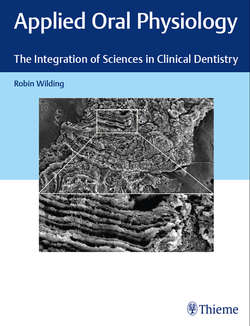Читать книгу Applied Oral Physiology - Robin Wilding - Страница 15
На сайте Литреса книга снята с продажи.
2.1.5 Arrested Enamel Caries
ОглавлениеThe early lesion in enamel may be reversed and remineralized if plaque is removed. Ion exchange on the surface of enamel is a dynamic process which is occurring all the time. It is influenced by the degree of saturation of calcium and phosphate salts in plaque and saliva and the level of fluoride in the enamel and the adjacent plaque fluid. If the fluid surrounding the early lesion is highly saturated, crystals of apatite may form on the outer surface zone and remineralize the enamel of the early lesion. However, minerals in saliva may also block further penetration of calcium ions into the deeper layers of the lesion. If remineralization takes place slowly, and in the presence of fluoride, extensive mineralization occurs throughout the lesion.
The major contribution of fluoride in caries prevention appears to be in the process of arresting early lesions and preventing their progression into irreversible enamel loss and the formation of a cavity. Fluoride is concentrated in arrested enamel lesions and at the margins of actual enamel cavities. This may be due to the breakdown of the enamel surface at the center of an early lesion and the subsequent massive loss of mineral in the center, leaving the margins relatively intact with high fluoride levels.
Arrested enamel lesions are often seen on an approximal surface some time after an adjacent tooth has been extracted. Simply by improving the self-cleansing of the approximal area, the extraction of a neighboring tooth helps to reduce plaque mass. The lesion is recognizable by a brown stain, sometimes surrounded by a halo of chalky white enamel. Fluoride accumulates in remineralizing enamel, making the enamel more resistant to subsequent acid attack. So, an arrested enamel lesion is more resistant to acid demineralization than it was originally, as each cycle of demineralization leaves the enamel stronger than it was before (▶ Fig. 2.6).
Fig. 2.3 Diagrammatic representation of the orientation of enamel prisms of a tooth illustrating the importance of avoiding leaving undermined enamel prisms during cavity preparation. (a) During cavity preparation it is important to ensure that angle of the cavity wall is prepared along the axis of enamel prisms. (b) Undermined margins leave fragments of prisms behind, which may fracture away from the cavity wall leaving a defect between the restoration of the tooth surface.
Fig. 2.4 The effect of acid etching an enamel surface. An SEM image (magnification × 1,000) of enamel surface after acid etching reveals that the interprismatic enamel has dissolved more rapidly than the prism core leaving a raise projection. In other areas, the core of the enamel prisms has dissolved more rapidly leaving a pitted surface, which provides mechanical retention for adhesive resins such as fissure sealants.
Fig. 2.5 A diagrammatic representation of the layers which can be defined in an early caries lesion which illustrate the dynamic nature of demineralization and remineralization. The early enamel lesion consists of four zones of alternating levels of mineralization. The surface zone (SZ) is remineralized but blocks the passage of calcium ions into the body of the lesion (B) which remains demineralized. It may have to be removed to allow the lesion to become arrested. The dark zone (DZ) is well mineralized, but the translucent zone (TZ) is yet again demineralized. (Adapted from Kidd and Joyston-Bechal 1987.)
Sometimes, the lesion progresses in spite of the availability of calcium and fluoride ions (▶ Fig. 2.7). This may be due to the presence of the barrier in the superficial zone, which we have noted above, restricts the movement of calcium and fluoride ions into the demineralized zone. This barrier may be due to plugging of the spaces between enamel crystals with salivary proteins.
Replacement minerals cannot get to the damaged site, but if the enamel surface is treated with a deproteinizing agent, remineralization occurs more readily. Remineralization may also be achieved by the removal of this superficial zone of the early lesion. This of course is more destructive than deproteinizing the surface, but there is evidence that tooth wear may be a significant process in arresting enamel lesions. If white lesions return to normal-looking enamel, either after orthodontic band removal or acid etching, it appears to be due to abrasion of the weakened enamel crystals by food and brushing. If remineralization does not occur as fast as the demineralization of enamel, eventually normal enamel structure is lost and a cavity develops.
Key Notes
Calcium hydroxyapatite ions are dissolving from and precipitating onto the enamel surface all the time. By reducing the acidity of the fluid surrounding the enamel surface, the balance toward mineralization instead of demineralization may be sustained. Even established lesions of demineralization may be reversed by fluoride treatment and careful oral hygiene.
Fig. 2.6 SEM images of enamel reveal remineralization of early caries. A SEM (magnification × 5,000s) of etched enamel surface from an area recognized clinically as arrested caries. (a) In the center of the lesion, there are clusters of remineralizations (R) which resisted acid etching during preparation of the specimen. (b) Toward the periphery of the lesion, the enamel has become well remineralized and the lesion has become arrested (A).
Fig. 2.7 The demineralization of the enamel surface in this SEM image of an early enamel carious lesion would have been irreversible. (Magnification × 300, window × 1,500).
